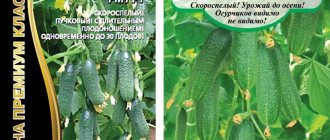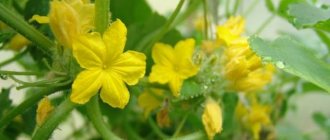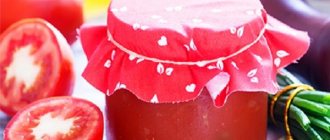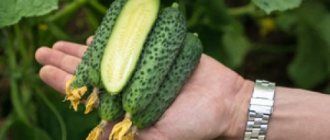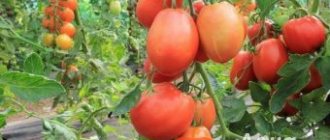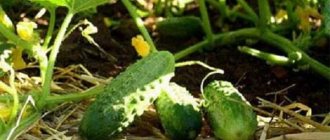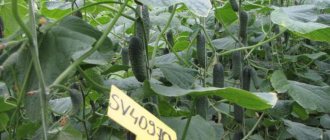Description of the Adam cucumber, its characteristics, growing region
Adam F1 is a parthenocarpic hybrid obtained in Holland. It is the fruit of the work of the famous seed company BejoZaden BV. This organization is engaged in obtaining new varieties of various vegetable crops. The hybrid came to Russia in 1989, but only in 2002 it was included in the State Register of the Russian Federation and recommended for cultivation in all climatic regions.
Since the Adam F1 cucumber can be planted in open ground, in temporary greenhouses, and in permanent greenhouses, there is no point in limiting the regions where it is grown. It is known both in the south of Stavropol and in the Leningrad region; it is planted by both amateur gardeners and farmers in large agricultural enterprises.
Adam F1 is an early-ripening cucumber; the first fruits are picked 45–52 days after emergence. It has high productivity, up to 10 kg/m2. Indeterminate, but the height of the bush with vertical cultivation is not prohibitive. It is on the trellis that this variety is usually grown. To pollinate female flowers, bees and other flying insects are not required, at the same time, the availability of plants for insects does not affect the shape of the fruits and their quality, which explains the possibility of growing the variety in open ground.
The stems are thick, light green, the leaves are small, their color ranges from green to dark green. It is highly resistant to a range of diseases, in particular:
- powdery mildew,
- cucumber mosaic,
- olive spot.
Zelentsy have a rich dark green color, finely tuberculate, with white pubescence. Their length is about 10 cm, diameter is 3–4 cm, weight is about 90 g. The taste of fresh fruits is assessed as very good.
It should be borne in mind that the taste qualities of such parthenocarpic varieties of Dutch selection as Amur 1801, Atik, Yildo, Infinity are rated somewhat higher: they are characterized as excellent.
The fruits of the Adam variety have the usual cucumber aroma and a sweetish aftertaste. In a cool place, the fruits can be stored for up to 2 weeks. Regarding the direction of use, the data in the State Register is contradictory: both salad and canning purposes are indicated, which apparently indicates the universal use of the crop.
Appearance
The appearance of Adam cucumbers differs favorably from varieties that in the recent past were called the offensive word “greenhouse”. Both in shape and color, it meets all the characteristics of a traditional “crispy” cucumber, and the presence of tubercles and pubescence only emphasizes the elegance of this cucumber .
Cucumber Adam is a “classic of the genre” in shape: appetizing both outside and inside
Advantages and disadvantages of a hybrid
The popularity of the Adam F1 cucumber is due to the advantages noted by specialists and amateurs. The positive qualities of a hybrid include:
- good yield;
- early but extended fruiting;
- excellent presentation of greens;
- good taste;
- ability to transport and preserve the crop;
- resistance to major diseases;
- self-pollinating.
The noted characteristics allow us to recommend the hybrid to beginning gardeners. But you should also take into account the disadvantages, of which there are few, for example:
- inability to use seeds from your harvest;
- thin peel, forcing you to handle greens with caution.
The peculiarity of the Adam cucumber is that it feels equally good both in the greenhouse and in the open ground; both the yield and the quality of the fruit practically do not depend on the location . Are there any other cucumbers like this? Of course there is. The variety of varieties both in the State Register lists and in any store is such that choosing the right one is very difficult; a description of the characteristics of the variety, its cultivation and use, as well as reviews from experienced gardeners, which you should always pay attention to when choosing a variety, can help with this.
There are amateurs who try every year to try out all the new hybrids that come into being, but this is becoming increasingly difficult to do. There are summer residents who prefer traditional old varieties and receive good harvests from the well-known Nezhinsky, Altaisky, Konkurent, etc. In addition, you can get your own seeds from varieties (not hybrids). It is difficult to give recommendations on choosing a variety when there are many hundreds of them. It’s probably better to choose a variety “for yourself” by trial and error.
Video: Adam cucumbers in the greenhouse
Reviews
Anna, 45 years old
I grow Adam F1 in a polycarbonate greenhouse. Although it is small, the harvest from year to year is sufficient to feed the whole family. The greens are uniform, do not overgrow and do not turn yellow. The preparations made from them are simply excellent. Before planting plants, I disinfect the soil with Fitosporin. For 2 years of cultivating the culture, I did not encounter any problems.
Svyatoslav, 60 years old
After reading positive reviews about the cucumber, Adam F1 decided to plant it in his summer cottage. And this experiment was a success. The variety turned out to be unpretentious and high-yielding. I didn't find any cons for myself. After setting the first greens, I fed the bushes with yeast 4 times a season: mixed 200 g of yeast with a glass of sugar and diluted it in 10 liters of water, and let the product brew for several hours. The prepared fertilizer was diluted with water in a ratio of 1:5 and poured in a volume of 1 liter under each bush.
Hybrid Adam F1 is loved by farmers due to such advantages as high yield, early ripeness, long fruiting period, self-pollination and high phytoimmunity. Thanks to these features, the variety can be grown by beginners and inexperienced gardeners. Among the disadvantages of cucumber are the inability to use personally collected seeds and the thin peel of the fruit, which does not allow them to be transported over long distances.
Features of planting and growing cucumber Adam
The agricultural technology of Adam cucumbers differs little from that of most early-ripening varieties of universal use. Both direct sowing of seeds in the ground and cultivation through the seedling stage are possible . In the south, if there is no need to obtain early produce, they do not grow seedlings, and in the northern regions the seedless method is rarely used.
Growing seedlings
Adam cucumber seeds are sowed in cups a month before seedlings are planted in the garden or greenhouse. Planting seedlings in the garden is carried out when the soil temperature is at least 15 ° C, as well as the transition of night air temperatures through 10 ° C. In the middle zone, this is the beginning of June, so sowing seeds for seedlings is carried out no earlier than the end of April.
The timing of sowing seedlings for a greenhouse is determined by the quality of this greenhouse.
Preparation of Adam F1 cucumber seeds, like any hybrid, is not required. If there are puny seeds in the bag, it is better to throw them away. The seeds are not cheap, so they are planted one at a time. The capacity of the cups is at least 250 ml, it is better to take peat pots . If you don’t have the ingredients for your own soil, you can buy it in a store, or you can make it up from peat, turf soil, sawdust, and humus.
Adam cucumber seeds are sown to a depth of 1.5 cm, watered well, covered with glass and placed in a bright place with a temperature of 25–28 °C. After the emergence of seedlings after 5–8 days, the temperature is reduced to 17–18 °C and left at this level for 4–5 days. Subsequently, cultivation is continued at 24 °C during the day and 18 °C at night.
There is no need to try to grow seedlings in a common box: cucumbers are planted in a garden bed, trying not to damage the roots even to the minimum extent
Caring for seedlings is simple: it involves watering and, if the bushes stop growing, one feeding with a solution of complex fertilizer. Shortly before planting in the garden, the seedlings are hardened off by taking them out onto the balcony for a short time.
Recent Entries
5 working ways to use tar in the garden 7 indoor plants that help you get married even in adulthood Indoor plants that can bloom in trouble
Planting Adam cucumbers in open ground and greenhouse
Cucumbers need fertile beds; even fresh manure is suitable for fertilization, the dose is 2-3 buckets per 1 m2. The best predecessors are cabbage, legumes and potatoes. In open ground, “warm beds” are often prepared by burying a “cushion” of various organic wastes in the ground in advance. Adam cucumber seedlings are planted without shelter in the middle zone no earlier than the beginning of summer. The seedlings are removed with a lump of earth and planted without burial. Water well and mulch. Direct sowing of seeds into the bed is carried out a week earlier, to a depth of 2.5–3 cm. Since they try to grow the Adam cucumber on a trellis, dense planting is possible, after 25–30 cm.
Planting seedlings or sowing seeds in a greenhouse is carried out similarly, the timing depends on the quality of the greenhouse: this is done when the required air and soil temperatures are reached. It is convenient to plant the Adam cucumber both at the side wall and opposite the entrance to the greenhouse (in the latter case, 2 rows are planted on both sides of the trellis).
You shouldn’t let Adam cucumber vines fall on the ground: when grown vertically, care is easier and the yield is higher
Caring for cucumbers Adam
In a greenhouse, the yield of this cucumber may be slightly higher, but in open ground, cucumbers are usually tastier. The main concerns are watering, fertilizing, forming vines, and timely harvesting of cucumbers. Watering is carried out in the evening, with water heated in the sun. The frequency and consumption of water depend on the weather, but the soil should not dry out. They loosen it only to a shallow depth; the weeds are pulled out by hand.
Adam cucumbers are fed up to 4 times a summer, trying to use organic matter. First, 2 weeks after planting the seedlings, then with the appearance of the first flowers and during the period of intensive fruiting.
When 4–5 leaves appear, the main stem of the Adam cucumber is tied with a soft ribbon to a support, then as it grows. When the height reaches 50 cm, the side shoots are removed. After the central stem reaches the height of the trellis, it is pinched, and the side stems are pinched: to a height of 1 m above the 3rd leaf, up to 1.5 m above the 4th, up to 2 m above the 5th. You can regulate the load on the plant by removing certain side shoots. Old lower leaves are torn off as they turn yellow. Gradually, the main fruiting of this hybrid moves up the canes; this is a normal process.
If space allows, indeterminate cucumbers can not be pinched at the top, but canes can be hung from the top wire of the trellis
The harvest must be harvested systematically, preferably every other day: this stimulates the appearance of new cucumbers. They do this early in the morning or late in the evening, helping themselves with pruners or scissors.
Further care
Adam F1 is a non-capricious plant and does not require complex care. To get a good harvest, weeds are regularly removed and the soil is loosened. When the roots are exposed, the bushes spud up. Before flowering, the plant is watered every week. With the onset of fruiting, the frequency of this procedure is increased to twice a week. In hot and dry weather, the soil is moistened daily.
Watering is carried out in the morning or evening. Then the vegetables turn out juicy. At the same time, be sure to ensure that the liquid does not get on the tops, as this can lead to the development of diseases. Before watering, the water from the tap is allowed to settle for time so that the chlorine is removed from it. The liquid must be heated to 23-25°C. Watering with cold water can cause the plant to stop growing and reduce yield.
Cucumbers have a superficial root system. For the active formation of lashes and ovaries, they need to be fed. Stages of using fertilizers:
- Before flowering. 1 cup of cow manure is dissolved in 10 liters of water, and then 1 tsp is added. superphosphate and potassium sulfate. After 7-10 days, dilute ½ cup of cow manure in a bucket of water and add 1 tbsp. l. nitrophoska. The plants are watered with the prepared mixture.
- During fruiting. 25 g of potassium nitrate are diluted in 15 liters of water and the solution is poured over the cucumbers. This stimulates the growth of all parts of the plant and improves the taste of vegetables.
Attention!
An excess of fertilizers is just as dangerous as a lack of them. Thus, excess nitrogen can cause the tops to fatten and delay flowering, excess phosphorus can lead to yellowing and shedding of foliage, and potassium can lead to slower growth of the bush.
Shaping and garter
It is not difficult to form a bush on a trellis. Novice summer residents can cope with this. They do it like this:
- stepsons, flowers and ovaries in the axils of the first 5 leaves are pinched, as they prevent the active growth of the central part;
- as the main lash increases, it is tied to the trellis with twine;
- The main cane is pinched or thrown over the top of the trellis so that it grows down after it reaches the top of the trellis.
It is worth noting that the formation of a bush can occur differently. It depends on the weather and what result the summer resident ultimately wants to get. In long and hot summers, pinching can be abandoned to obtain a rich harvest. If the summer resident does not pursue such a goal as obtaining a rich harvest, all stepsons can be removed. The green plants constantly go up, so the summer resident can gradually cut off the lower leaves to the nearest ovaries.
Pest and disease control
Adam F 1 has high resistance to viral mosaic, powdery mildew and cladosporiosis. However, when growing this variety, farmers sometimes encounter the following problems:
- Downy mildew. The causative agent of the disease is a pathogenic fungus. When it occurs, the leaves become covered with brown spots and dry out. High air humidity and poor ventilation lead to the problem. It is under such conditions that pathogen spores easily penetrate plant tissue. To combat the disease, agents with fungicidal properties (Bordeaux mixture, Oxychom) are used.
- Medvedka. This is an insect that lives in the ground and eats the roots of the plant. It can enter the garden from neighboring lands or together with imported organic fertilizers. The problem is eliminated by deep plowing the soil and destroying the passages. Chemicals are also used (for example, “Thunder”).
- Aphid. She drinks the juice of plants and thereby provokes their death. The pest is eliminated using insecticides (for example, Actofit).
Attention!
The presence of insect pests on cucumbers increases the risk of fungal and viral diseases.

